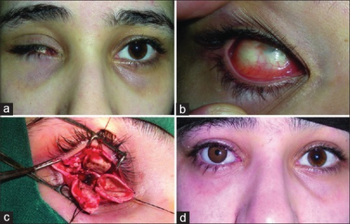Phthisis bulbi
| Phthisis bulbi | |
|---|---|
 | |
| Phthisis bulbi of the person's right eye due to complication of eye surgery | |
| Symptoms | Shrunken eye with little or no function |
| Causes | Eye surgery |
| Risk factors | Eye injury, Eye surgery, eye disease |
| Prevention | By treating the condition before the eye goes to pthisis |
| Treatment | Surgery |
| Prognosis | Usually permanent blindness in affected eye |
| Deaths | 0 |
Phthisis bulbi is a shrunken,[1] non-functional eye. It may result from severe eye disease, inflammation[2] or injury, or it may represent a complication of eye surgery.[3] Treatment options include insertion of a prosthesis, which may be preceded by enucleation of the eye.[4][5]
Symptoms and signs
The affected eye is shrunken, and has little to no vision. The intraocular pressure in the affected eye is very low or nonexistent. The layers in the eye may be fused together, thickened, or edematous. The eyelids may be glued shut. The eye may be soft when palpated.[6] Under a microscope there may be deposits of calcium or bone, and the cornea is often affected by cataracts.[7]
Causes
It can be caused by injury, including burns to the eye, or long-term eye disease or inflammation. End-stage glaucoma can cause it. It can often complicate eye surgery.[6] Other common causes include cancer, retinal detachment, vascular lesions, infection, and inflammation.[7]
Diagnosis
Differential diagnosis
The DDx of this ocular condition is based on the following:[8]
- Retinoblastoma
- Malignant uveal melanoma
- Microphthalmos
- Microcornea
Treatment

Treatment for the affected eye is often futile. Usually, treatment is to end the pain in the affected eye and for cosmetic purposes, not to restore vision.[7]
It can be removed, a procedure called enucleation of the eye. Sometimes, though, it is possible to transplant only parts of the eye, and some vision can be restored.[6]
References
- ↑ Dornblüth, von Willibald Pschyrembel. Gegr. von Otto (1977). Klinisches Wörterbuch : mit klinischen Syndromen und einem Anhang Nomina Anatomica (253., um einen Anh. 'Nomina anatomica' erw. Aufl. ed.). Berlin [u.a.]: de Gruyter. ISBN 978-3-11-007018-7.
- ↑ Hui JI (September 2010). "Outcomes of orbital implants after evisceration and enucleation in patients with endophthalmitis". Curr Opin Ophthalmol. 21 (5): 375–9. doi:10.1097/ICU.0b013e32833b7a56. PMID 20489621.
- ↑ Apple DJ, Jones GR, Reidy JJ, Loftfield K (1985). "Ocular perforation and phthisis bulbi secondary to strabismus surgery". J Pediatr Ophthalmol Strabismus. 22 (5): 184–7. PMID 4045647.
- ↑ Cote RE, Haddad SE (1990). "Fitting a prosthesis over phthisis bulbi or discolored blind eyes". Adv Ophthalmic Plast Reconstr Surg. 8: 136–45. PMID 2248703.
- ↑ Soares IP, França VP (May 2010). "Evisceration and enucleation". Semin Ophthalmol. 25 (3): 94–7. doi:10.3109/08820538.2010.488575. PMID 20590419.
- ↑ 6.0 6.1 6.2 Dohlman CH, D'Amico DJ (January 1999). "Can an eye in phthisis be rehabilitated? A case of improved vision with 1-year follow-up". Arch Ophthalmol. 117 (1): 123–4. doi:10.1001/archopht.117.1.123. PMID 9930175.
- ↑ 7.0 7.1 7.2 Tripathy K, Chawla R, Temkar S, Sagar P, Kashyap S, Pushker N, Sharma YR (2018). "Phthisis Bulbi-a Clinicopathological Perspective". Semin Ophthalmol. 33 (6): 788–803. doi:10.1080/08820538.2018.1477966. PMID 29902388.
- ↑ "Phthisis bulbi - EyeWiki". www.eyewiki.org. Archived from the original on 15 July 2022. Retrieved 22 July 2022.
External links
| Classification |
|---|